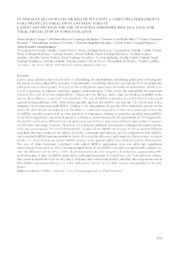Últimos avanços no uso de RNA de fita dupla como ferramenta para proteção viral em plantas de tomate.
Últimos avanços no uso de RNA de fita dupla como ferramenta para proteção viral em plantas de tomate.
Author(s): VARGAS, J. R.; SOUSA, B. M. C. de; SILVA, D. Y. M.; MARTINS, Y. F.; PEREIRA, W. de S.; PETRONIO, M. S.; NAKASU, E. Y. T.; INOUE-NAGATA, A. K.
Summary: Latest advances in the use of double-stranded RNA as tool for viral protection in tomato plants. Lately, great attention has been diverted to elucidating the mechanisms underlining plant gene silencing and the action of non-coding RNA in plants. Concomitantly, knowledge about the interactions between plants and pathogens has evolved greatly, bringing to the spotlight the importance of double-stranded RNA (dsRNA) as a tool to generate or improve resistance against plant pathogens. Plant viruses are responsible for important losses in the yield of several commodities. Viruses are very diverse, and to date, no products available in the market allow effective control of viral infections. The use of dsRNA molecules as a tool is based on the plant gene-silencing pathways (GS). After being topically applied, the dsRNA can activate GS, which uses it as a template for synthesizing small RNAs, leading to the degradation of specific RNA molecules present in the plant cell.
Publication year: 2023
Types of publication: Abstract in annals or event proceedings
Unit: Embrapa Vegetables
Keywords: Chitosan, DsRNA, Nanoencapsulation, Plant hormones, Planta, Tomate, Vírus
Observation
Some of Embrapa's publications are published as ePub files. To read them, use or download one of the following free software options to your computer or mobile device. Android: Google Play Books; IOS: iBooks; Windows and Linux: Calibre.
Access other publications
Access the Agricultural Research Database (BDPA) to consult Embrapa's full library collection and records.
Visit Embrapa Bookstore to purchase books and other publications sold by Embrapa.

